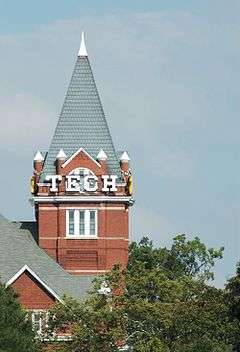Georgia (U.S. state)
| State of Georgia | |||||
|---|---|---|---|---|---|
| |||||
|
Nickname(s): Peach State; Empire State of the South | |||||
| Motto(s): Wisdom, Justice, Moderation | |||||
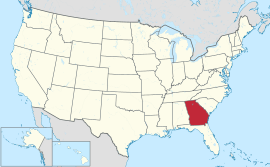 | |||||
| Official language | English | ||||
| Spoken languages | English, Spanish (7.42%) | ||||
| Demonym | Georgian | ||||
| Capital (and largest city) | Atlanta | ||||
| Largest metro | Atlanta metro area | ||||
| Area | |||||
| • Total |
59,425 sq mi (153,909 km2) | ||||
| • Width | 230 miles (370 km) | ||||
| • Length | 298 miles (480 km) | ||||
| • % water | 2.6 | ||||
| • Latitude | 30.356 – 34.985° N | ||||
| • Longitude | 80.840 – 85.605° W | ||||
| Population | |||||
| • Total | 10,214,860 (2015 est)[1] | ||||
| • Density |
165/sq mi (65.4/km2) Ranked 18th | ||||
| • Median household income | $47,590 (2009) (29th) | ||||
| Elevation | |||||
| • Highest point |
Brasstown Bald[2][3] 4,784 ft (1458 m) | ||||
| • Mean | 600 ft (180 m) | ||||
| • Lowest point |
Atlantic Ocean[2] sea level | ||||
| Before statehood | Province of Georgia | ||||
| Admission to Union | January 2, 1788 (4th) | ||||
| Governor | Nathan Deal (R) | ||||
| Lieutenant Governor | Casey Cagle (R) | ||||
| Legislature | |||||
| • Upper house | State Senate | ||||
| • Lower house | House of Representatives | ||||
| U.S. Senators |
Johnny Isakson (R) David Perdue (R) | ||||
| U.S. House delegation | 10 Republicans, 4 Democrats (list) | ||||
| Time zone | Eastern: UTC −5/−4 | ||||
| ISO 3166 | US-GA | ||||
| Abbreviations | GA, Ga. | ||||
| Website |
www | ||||
| Georgia state symbols | |
|---|---|
|
The Flag of Georgia | |
|
The Seal of Georgia | |
| Living insignia | |
| Amphibian | American green tree frog |
| Bird | Brown thrasher (Toxostoma rufum) |
| Butterfly | Eastern tiger swallowtail (Papilio glaucus) |
| Fish | Largemouth bass |
| Flower | Azalea |
| Insect | Honeybee |
| Reptile | Gopher tortoise (Gopherus polyphemus) |
| Tree | Southern Live Oak (Quercus virginiana) |
| Inanimate insignia | |
| Food | Grits, peanut |
| Fossil | Shark tooth |
| Gemstone | Quartz |
| Mineral | Staurolite |
| Shell | Knobbed Whelk |
| Song | "Georgia on My Mind" |
| Other | Vegetable: Vidalia sweet onion |
| State route marker | |
 | |
| State quarter | |
|
Released in 1999 | |
| Lists of United States state symbols | |
Georgia (![]() i/ˈdʒɔːrdʒə/ JOR-juh) is a state in the southeastern United States. It was established in 1733, the last of the original Thirteen Colonies.[4] Named after King George II of Great Britain,[5] Georgia was the fourth state to ratify the United States Constitution, on January 2, 1788.[6] It declared its secession from the Union on January 19, 1861, and was one of the original seven Confederate states.[6] It was the last state to be restored to the Union, on July 15, 1870.[6] Georgia is the 24th largest and the 8th most populous of the 50 United States. From 2007 to 2008, 14 of Georgia's counties ranked among the nation's 100 fastest-growing, second only to Texas.[7] Georgia is known as the Peach State and the Empire State of the South.[6] Atlanta is the state's capital and most populous city and is a named global city, also called world city or sometimes alpha city or world center, a city generally considered to be an important node in the global economic system.
i/ˈdʒɔːrdʒə/ JOR-juh) is a state in the southeastern United States. It was established in 1733, the last of the original Thirteen Colonies.[4] Named after King George II of Great Britain,[5] Georgia was the fourth state to ratify the United States Constitution, on January 2, 1788.[6] It declared its secession from the Union on January 19, 1861, and was one of the original seven Confederate states.[6] It was the last state to be restored to the Union, on July 15, 1870.[6] Georgia is the 24th largest and the 8th most populous of the 50 United States. From 2007 to 2008, 14 of Georgia's counties ranked among the nation's 100 fastest-growing, second only to Texas.[7] Georgia is known as the Peach State and the Empire State of the South.[6] Atlanta is the state's capital and most populous city and is a named global city, also called world city or sometimes alpha city or world center, a city generally considered to be an important node in the global economic system.
Georgia is bordered to the south by Florida, to the east by the Atlantic Ocean and South Carolina, to the west by Alabama, and to the north by Tennessee and North Carolina. The state's northern part is in the Blue Ridge Mountains, part of the Appalachian Mountains system. The Piedmont extends through the central part of the state from the foothills of the Blue Ridge to the Fall Line, where the rivers cascade down in elevation to the coastal plain of the state's southern part. Georgia's highest point is Brasstown Bald at 4,784 feet (1,458 m) above sea level; the lowest is the Atlantic Ocean. Georgia is the largest state east of the Mississippi River in land area.[8]
History
Before settlement by Europeans, Georgia was inhabited by the mound building cultures. The British colony of Georgia was founded by James Oglethorpe on February 12, 1733.[9] The colony was administered by the Trustees for the Establishment of the Colony of Georgia in America under a charter issued by (and named for) King George II. The Trustees implemented an elaborate plan for the colony's settlement, known as the Oglethorpe Plan, which envisioned an agrarian society of yeoman farmers and prohibited slavery. In 1742 the colony was invaded by the Spanish during the War of Jenkins' Ear. In 1752, after the government failed to renew subsidies that had helped support the colony, the Trustees turned over control to the crown. Georgia became a crown colony, with a governor appointed by the king.[10]

The Province of Georgia was one of the Thirteen Colonies that revolted against British rule in the American Revolution by signing the 1776 Declaration of Independence. The State of Georgia's first constitution was ratified in February 1777. Georgia was the 10th state to ratify the Articles of Confederation on July 24, 1778,[11] and was the 4th state to ratify the current Constitution on January 2, 1788.
In 1829, gold was discovered in the North Georgia mountains, which led to the Georgia Gold Rush and an established federal mint in Dahlonega, which continued its operation until 1861. The subsequent influx of white settlers put pressure on the government to take land from the Cherokee Nation. In 1830, President Andrew Jackson signed the Indian Removal Act into law, sending many eastern Native American nations to reservations in present-day Oklahoma, including all of Georgia's tribes. Despite the Supreme Court's ruling in Worcester v. Georgia (1832) that ruled U.S. states were not permitted to redraw the Indian boundaries, President Jackson and the state of Georgia ignored the ruling. In 1838, his successor, Martin Van Buren, dispatched federal troops to gather the Cherokee and deport them west of the Mississippi. This forced relocation, known as the Trail of Tears, led to the death of over 4,000 Cherokees.
In early 1861, Georgia joined the Confederacy and became a major theater of the Civil War. Major battles took place at Chickamauga, Kennesaw Mountain, and Atlanta. In December 1864, a large swath of the state from Atlanta to Savannah was destroyed during General William Tecumseh Sherman's March to the Sea. 18,253 Georgian soldiers died in service, roughly 1 of every 5 who served.[12] In 1870, following the Reconstruction Era, Georgia became the last Confederate state to be restored to the Union.

With white Democrats having regained power in the state legislature, they passed a poll tax in 1877, which disenfranchised many poor blacks and whites, preventing them from registering.[13] In 1908, the state established a white primary; with the only competitive contests within the Democratic Party, it was another way to exclude blacks from politics.[14] They constituted 46.7% of the state's population in 1900, but the proportion of Georgia's population that was African American dropped thereafter to 28% primarily due to leaving the state during the Great Migration.[15] This disfranchisement persisted through the mid-1960s, until federal legislation with the Voting Rights Act of 1965.
Geography


Boundaries
Beginning from the Atlantic Ocean, the state's eastern border with South Carolina runs up the Savannah River, northwest to its origin at the confluence of the Tugaloo and Seneca Rivers. It then continues up the Tugaloo (originally Tugalo) and into the Chattooga River, its most significant tributary. These bounds were decided in the 1797 Treaty of Beaufort, and tested in the U.S. Supreme Court in the two Georgia v. South Carolina cases in 1923 and 1989.
The border then takes a sharp turn around the tip of Rabun County, at latitude 35°N, though from this point it diverges slightly south (due to inaccuracies in the original survey). This northern border was originally the Georgia and North Carolina border all the way to the Mississippi River, until Tennessee was divided from North Carolina, and the Yazoo companies induced the legislature of Georgia to pass an act, approved by the governor in 1795, to sell the greater part of Georgia's territory presently comprising Alabama and Mississippi.[16]
The state's western border runs in a straight line south-southeastward from a point southwest of Chattanooga, to meet the Chattahoochee River near West Point. It continues downriver to the point where it joins the Flint River (the confluence of the two forming Florida's Apalachicola River); the southern border goes almost due east and very slightly south, in a straight line to the St. Mary's River, which then forms the remainder of the boundary back to the ocean.
The water boundaries are still set to be the original thalweg of the rivers. Since then, several have been inundated by lakes created by dams, including the Apalachicola/Chattahoochee/Flint point now under Lake Seminole.
Georgia state legislators have claimed that in an 1818 survey, the state's border with Tennessee was erroneously placed one mile (1.6 km) farther south than intended, and they proposed a correction in 2010. The state was then in the midst of a significant drought, and the new border would allow Georgia access to water from the Tennessee River.[17]
Geology and terrain
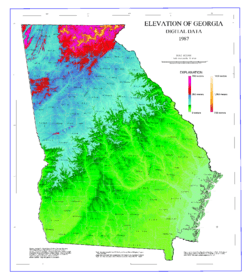
Each region has its own distinctive characteristics. For instance, the Ridge and Valley, which lies in the northwest corner of the state, includes limestone, sandstone, shale and other sedimentary rocks, which have yielded construction-grade limestone, barite, ocher, and small amounts of coal.
Flora
The state of Georgia has approximately 250 tree species and 58 protected plants. Georgia's native trees include red cedar, a variety of pines, oaks, hollies, cypress, sweetgum, scaly-bark and white hickories and sabal palmetto. East Georgia is in the subtropical coniferous forest biome and conifer species as other broadleaf evergreen flora make up the majority of the southern and coastal regions. Yellow jasmine, and mountain laurel make up just a few of the flowering shrubs in the state.
Fauna
White-tailed (Virginia) deer are in nearly all counties. The northern mockingbird and brown thrasher are among the 160 bird species that live in the state.[18]
Reptiles and amphibians include the eastern diamondback, copperhead, and cottonmouth, salamanders, frogs, alligators and toads. There are about 79 species of reptile and 63 amphibians known to live in Georgia.[18]
The most popular freshwater game fish are trout, bream, bass, and catfish, all but the last of which are produced in state hatcheries for restocking. Popular saltwater game fish include red drum, spotted seatrout, flounder, and tarpon. Porpoises, whales, shrimp, oysters, and blue crabs are found inshore and offshore of the Georgia coast.[18]
Climate
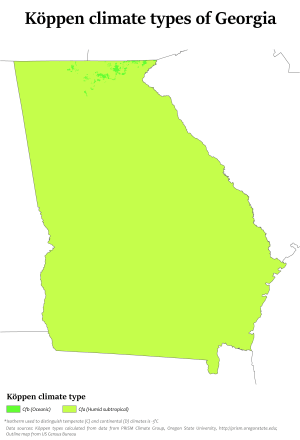

The majority of the state is primarily a humid subtropical climate. Hot and humid summers are typical, except at the highest elevations. The entire state, including the North Georgia mountains, receives moderate to heavy precipitation, which varies from 45 inches (1143 mm) in central Georgia[19] to approximately 75 inches (1905 mm) around the northeast part of the state.[20] The degree to which the weather of a certain region of Georgia is subtropical depends on the latitude, its proximity to the Atlantic Ocean or Gulf of Mexico, and the elevation. The latter factor is felt chiefly in the mountainous areas of the northern part of the state, which are farther away from the ocean and can be 4500 feet (1350 m) above sea level. The USDA Plant hardiness zones for Georgia range from zone 6b (no colder than −5 °F (−21 °C) ) in the Blue Ridge Mountains to zone 8b (no colder than 15 °F (−9 °C) ) along the Atlantic coast and Florida border.[21]
The highest temperature ever recorded is 112 °F (44.4 °C) in Louisville on July 24, 1952,[22] while the lowest is −17 °F (−27.2 °C) in northern Floyd County on January 27, 1940.[23] Georgia is one of the leading states in frequency of tornadoes, though they are rarely stronger than F1. Although tornadoes striking the city are very rare,[24] a F2 nonviolent tornado[24] hit downtown Atlanta on March 14, 2008, causing moderate to severe damage to various buildings. With a coastline on the Atlantic Ocean, Georgia is also vulnerable to hurricanes, although direct hurricane strikes were rare during the 20th century. Georgia often is affected by hurricanes that strike the Florida panhandle, weaken over land, and bring strong tropical storm winds and heavy rain to the interior, as well as hurricanes that come close to the Georgia coastline, brushing the coast on their way north.
| City | Jan | Feb | Mar | Apr | May | Jun | Jul | Aug | Sep | Oct | Nov | Dec |
|---|---|---|---|---|---|---|---|---|---|---|---|---|
| Athens | 51/11 33/1 |
56/13 35/2 |
65/18 42/6 |
73/23 49/9 |
80/27 58/14 |
87/31 65/18 |
90/32 69/21 |
88/31 68/20 |
82/28 63/17 |
73/23 51/11 |
63/17 42/6 |
54/12 35/2 |
| Atlanta | 52/11 34/1 |
57/14 36/2 |
65/18 44/7 |
73/23 50/10 |
80/27 60/16 |
86/30 67/19 |
89/32 71/22 |
88/31 70/21 |
82/28 64/18 |
73/23 53/12 |
63/17 44/7 |
55/13 36/2 |
| Augusta | 56/13 33/1 |
61/16 36/4 |
69/21 42/6 |
77/25 48/9 |
84/29 57/14 |
90/32 65/18 |
92/33 70/21 |
90/32 68/20 |
85/29 62/17 |
76/24 50/10 |
68/20 41/5 |
59/15 35/2 |
| Columbus | 57/14 37/3 |
62/17 39/4 |
69/21 46/8 |
76/24 52/11 |
83/28 61/16 |
90/32 69/21 |
92/33 72/22 |
91/32 72/22 |
86/30 66/19 |
77/25 54/12 |
68/20 46/8 |
59/15 39/4 |
| Macon | 57/14 34/1 |
61/16 37/3 |
68/20 44/7 |
76/24 50/10 |
83/28 59/15 |
90/32 67/19 |
92/33 70/21 |
90/32 70/21 |
85/29 64/18 |
77/25 51/11 |
68/20 42/6 |
59/15 36/2 |
| Savannah | 60/16 38/3 |
64/18 41/5 |
71/22 48/9 |
78/26 53/12 |
84/29 61/16 |
90/32 68/20 |
92/33 72/22 |
90/32 71/22 |
86/30 67/19 |
78/26 56/13 |
70/21 47/8 |
63/17 40/4 |
| Temperatures are given in °F/°C format, with highs on top of lows.[25] | ||||||||||||
Demographics
| Historical population | |||
|---|---|---|---|
| Census | Pop. | %± | |
| 1790 | 82,548 | — | |
| 1800 | 162,686 | 97.1% | |
| 1810 | 251,407 | 54.5% | |
| 1820 | 340,989 | 35.6% | |
| 1830 | 516,823 | 51.6% | |
| 1840 | 691,392 | 33.8% | |
| 1850 | 906,185 | 31.1% | |
| 1860 | 1,057,286 | 16.7% | |
| 1870 | 1,184,109 | 12.0% | |
| 1880 | 1,542,181 | 30.2% | |
| 1890 | 1,837,353 | 19.1% | |
| 1900 | 2,216,331 | 20.6% | |
| 1910 | 2,609,121 | 17.7% | |
| 1920 | 2,895,832 | 11.0% | |
| 1930 | 2,908,506 | 0.4% | |
| 1940 | 3,123,723 | 7.4% | |
| 1950 | 3,444,578 | 10.3% | |
| 1960 | 3,943,116 | 14.5% | |
| 1970 | 4,589,575 | 16.4% | |
| 1980 | 5,463,105 | 19.0% | |
| 1990 | 6,478,216 | 18.6% | |
| 2000 | 8,186,453 | 26.4% | |
| 2010 | 9,687,653 | 18.3% | |
| Est. 2015 | 10,214,860 | 5.4% | |
| 1910–2010[26] 2015 Estimate[1] | |||
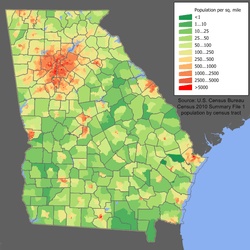
The United States Census Bureau estimates that the population of Georgia was 10,214,860 on July 1, 2015, a 5.44% increase since the 2010 United States Census.[1]
In 2015, Georgia had an estimated population of 10,214,860 which was an increase of 117,517 from the previous year, and an increase of 527,207 since 2010. This includes a natural increase since the last census of 438,939 people (that is 849,414 births minus 410,475 deaths) and an increase from net migration of 606,673 people into the state. Immigration resulted in a net increase of 228,415 people, and migration within the country produced a net increase of 378,258 people.
As of 2010, the state has the sixth highest number of illegal immigrants in the country. There were 35,000 in 1990; the count more than doubled from January 2000 to January 2009, at 480,000.[27]
There were 743,000 veterans in 2009.[28]
Race and age
According to the 2010 United States Census, Georgia had a population of 9,687,653. In terms of race and ethnicity, the state was 59.7% White (55.9% Non-Hispanic White Alone), 30.5% Black or African American, 0.3% American Indian and Alaska Native, 3.2% Asian, 0.1% Native Hawaiian and Other Pacific Islander, 4.0% from Some Other Race, and 2.1% from Two or More Races. Hispanics and Latinos of any race made up 8.8% of the population.[29]
| Racial composition | 1990[30] | 2000[31] | 2010[32] |
|---|---|---|---|
| White | 71.0% | 65.1% | 59.7% |
| Black | 27.0% | 28.7% | 30.5% |
| Asian | 1.2% | 2.1% | 3.3% |
| Native | 0.2% | 0.3% | 0.3% |
| Native Hawaiian and other Pacific Islander | - | 0.1% | 0.1% |
| Other race | 0.6% | 2.4% | 4.0% |
| Two or more races | - | 1.4% | 2.1% |
As of 2011, 58.8% of Georgia's population younger than age 1 were minorities (meaning that they had at least one parent who was not non-Hispanic white) compared to other states like California with 75.1%, New York with 55.6%, and Texas with 69.8%.[33]
The largest European ancestry groups are:
In the 1980 census 1,584,303 Georgians claimed English ancestry out of a total state population of 3,994,817, making them 40% of the state, and the largest ethnic group at the time.[36] Today, many of these same people claiming that they are of "American" ancestry are actually of English descent, and some are of Scots-Irish descent; however, their families have lived in the state for so long, in many cases since the colonial period, that they choose to identify simply as having "American" ancestry or do not in fact know their own ancestry. Their ancestry primarily goes back to the original thirteen colonies and for this reason many of them today simply claim "American" ancestry, though they are of predominately English ancestry.[37][38][39][40]
As of 2004, 7.7% of Georgia's population was reported as under 5 years of age, 26.4% under 18, and 9.6% were 65 or older. Also as of 2004, females made up approximately 50.6% of the population and African Americans made up approximately 29.6%.
Historically, about half of Georgia's population was composed of African Americans who, before the Civil War, were almost exclusively enslaved. The Great Migration of hundreds of thousands of blacks from the rural South to the industrial North from 1914–70 reduced the African American population.[41]
Georgia had the second-fastest-growing Asian population growth in the U.S. from 1990 to 2000, more than doubling in size during the ten-year period.[42] In addition, according to census estimates, Georgia ranks third among the states in terms of the percent of the total population that is African American (after Mississippi and Louisiana) and third in numerical Black population after New York and Florida. Georgia was the state with the largest numerical increase in the black population from 2006 to 2007 with 84,000.
Georgia is the state with the third-lowest percentage of older people (65 or older), at 12.8 percent (as of 2015).[43]
The colonial settlement of large numbers of Scottish American, English American and Scotch-Irish Americans in the mountains and piedmont, and coastal settlement by some English Americans and African Americans, have strongly influenced the state's culture in food, language and music. The concentration of Africans imported to coastal areas in the 18th century repeatedly from rice-growing regions of West Africa led to the development of Gullah-Geechee language and culture in the Low Country among African Americans. They share a unique heritage in which African traditions of food, religion and culture were continued more than in some other areas. In the creolization of Southern culture, their foodways became an integral part of all Southern cooking in the Low Country.[44][45]
Languages
| Language | Percentage of population (as of 2010)[46] |
|---|---|
| Spanish | 7.42% |
| Korean | 0.51% |
| Vietnamese | 0.44% |
| French | 0.42% |
| Chinese (including Mandarin) | 0.38% |
| German | 0.29% |
| Hindi | 0.23% |
| Niger-Congo languages of West Africa (Ibo, Kru, and Yoruba) | 0.21% |
| Gujarati | 0.18% |
| Portuguese and French Creole | 0.16% |
As of 2010, 87.35% (7,666,663) of Georgia residents age 5 and older spoke English at home as a primary language, while 7.42% (651,583) spoke Spanish, 0.51% (44,702) Korean, 0.44% (38,244) Vietnamese, 0.42% (36,679) French, 0.38% (33,009) Chinese (which includes Mandarin), and German, which was spoken as a main language by 0.29% (23,351) of the population over the age of five. In total, 12.65% (1,109,888) of Georgia's population age 5 and older spoke a mother language other than English.[46]
Major cities
| Largest cities or towns in Georgia (U.S. state) http://www.census.gov/popest/data/cities/totals/2015/SUB-EST2015-3.html | |||||||||
|---|---|---|---|---|---|---|---|---|---|
| Rank | Name | County | Pop. | ||||||
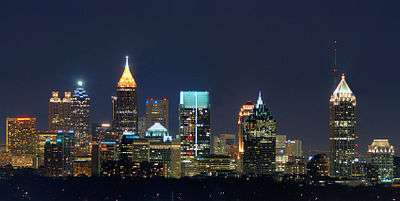 Atlanta  Columbus |
1 | Atlanta | Fulton | 463,878 | 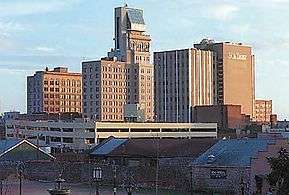 Augusta Macon | ||||
| 2 | Columbus | Muscogee | 200,579 | ||||||
| 3 | Augusta | Richmond | 197,182 | ||||||
| 4 | Macon | Bibb | 153,515 | ||||||
| 5 | Savannah | Chatham | 145,674 | ||||||
| 6 | Athens | Clarke | 122,604 | ||||||
| 7 | Sandy Springs | Fulton | 105,330 | ||||||
| 8 | Roswell | Fulton | 94,501 | ||||||
| 9 | Johns Creek | Fulton | 83,335 | ||||||
| 10 | Albany | Dougherty | 74,843 | ||||||
Populations indicated above are the latest 2015 estimates from the US Census Bureau. In 2012, voters in Macon and Bibb County approved the consolidation of the city of Macon and unincorporated Bibb County, and they officially merged on January 1, 2014. Macon joined Columbus, Augusta, and Athens as consolidated cities in Georgia.
- The U.S. Census Bureau lists fourteen metropolitan areas in Georgia. The largest, Atlanta, is the ninth most populous metro area in the United States.
Religion
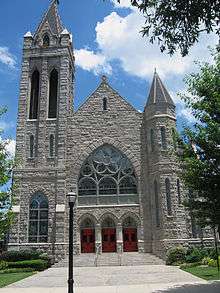
The composition of religious affiliation in Georgia is 70% Protestant, 9% Catholic, 1% Mormon, 1% Jewish, 0.5% Muslim, 0.5% Buddhist, and 0.5% Hindu. Atheists, deists, agnostics, and other unaffiliated people make up 13% of the population.[47] The largest Christian denominations by number of adherents in 2010 were the Southern Baptist Convention with 1,759,317; the United Methodist Church with 619,394; and the Roman Catholic Church with 596,384. Non-denominational Evangelical Protestant had 566,782 members, the Church of God (Cleveland, Tennessee) has 175,184 members, and the National Baptist Convention, USA, Inc. has 172,982 members.[48] The Presbyterian Church (USA) is the largest Presbyterian body in the state, with 300 congregations and 100,000 members. The other large body, Presbyterian Church in America, had at its founding date 14 congregations and 2,800 members; in 2010 it counted 139 congregations and 32,000 members.[49][50] The Roman Catholic Church is noteworthy in Georgia's urban areas, and includes the Archdiocese of Atlanta and the Diocese of Savannah. Georgia is home to the largest Hindu temple in the United States, the BAPS Shri Swaminarayan Mandir Atlanta. Georgia is home to several historical synagogues including The Temple (Atlanta), Congregation Beth Jacob (Atlanta), and Congregation Mickve Israel (Savannah). Chabad and the Rohr Jewish Learning Institute are also active in the state.[51][52]
Government
State government


As with all other US states and the federal government, Georgia's government is based on the separation of legislative, executive, and judicial power.[53] Executive authority in the state rests with the governor, currently Nathan Deal (Republican). Both the Governor of Georgia and lieutenant governor are elected on separate ballots to four-year terms of office. Unlike the federal government, but like many other U.S. States, most of the executive officials who comprise the governor's cabinet are elected by the citizens of Georgia rather than appointed by the governor.
Legislative authority resides in the General Assembly, composed of the Senate and House of Representatives. The Lieutenant Governor presides over the Senate, while members of the House of Representatives select their own Speaker. The Georgia Constitution mandates a maximum of 56 senators, elected from single-member districts, and a minimum of 180 representatives, apportioned among representative districts (which sometimes results in more than one representative per district); there are currently 56 senators and 180 representatives. The term of office for senators and representatives is two years.[54] The laws enacted by the General Assembly are codified in the Official Code of Georgia Annotated.
State judicial authority rests with the state Supreme Court and Court of Appeals, which have statewide authority.[55] In addition, there are smaller courts which have more limited geographical jurisdiction, including Superior Courts, State Courts, Juvenile Courts, Magistrate Courts and Probate Courts. Justices of the Supreme Court and judges of the Court of Appeals are elected statewide by the citizens in non-partisan elections to six-year terms. Judges for the smaller courts are elected to four-year terms by the state's citizens who live within that court's jurisdiction.
Local government
Georgia consists of 159 counties, second only to Texas, with 254.[56] Georgia had 161 counties until the end of 1931, when Milton and Campbell were merged into the existing Fulton. Some counties have been named for prominent figures in both American and Georgian history, and many bear names with Native American origin. Counties in Georgia have their own elected legislative branch, usually called the Board of Commissioners, which usually also has executive authority in the county.[57] Several counties have a sole Commissioner form of government, with legislative and executive authority vested in a single person. Georgia is the only state with Sole Commissioner counties. Georgia's Constitution provides all counties and cities with "home rule" authority. The county commissions have considerable power to pass legislation within their county, as a municipality would.
Georgia recognizes all local units of government as cities, so every incorporated town is legally a city. Georgia does not provide for townships or independent cities, though there have been bills proposed in the Legislature to provide for townships;[58] it does allow consolidated city-county governments by local referendum. All of Georgia's second-tier cities except Savannah have now formed consolidated city-county governments by referendum: Columbus (in 1970), Athens (1990), Augusta (1995), and Macon (2012). (Augusta and Athens have excluded one or more small, incorporated towns within their consolidated boundaries, while Macon has excluded a small unincorporated area; Columbus eventually absorbed all smaller incorporated entities within its consolidated boundaries.) The small town of Cusseta adopted a consolidated city-county government in 2003.
There is no true metropolitan government in Georgia, though the Atlanta Regional Commission (ARC) and Georgia Regional Transportation Authority do provide some services, and the ARC must approve all major land development projects in the Atlanta metropolitan area.
Elections
| Year | Republican | Democratic |
|---|---|---|
| 2012 | 53.40% 2,070,221 | 45.44% 1,761,761 |
| 2008 | 52.20% 2,048,744 | 47.00% 1,844,137 |
| 2004 | 57.97% 1,914,254 | 41.37% 1,366,149 |
| 2000 | 54.67% 1,419,720 | 42.98% 1,116,230 |
| 1996 | 47.01% 1,080,843 | 45.84% 1,053,849 |
| 1992 | 42.88% 995,252 | 43.47% 1,008,966 |
| 1988 | 59.75% 1,081,331 | 39.50% 714,792 |
| 1984 | 60.17% 1,068,722 | 39.79% 706,628 |
| 1980 | 40.95% 654,168 | 55.76% 890,733 |
| 1976 | 32.96% 483,743 | 66.74% 979,409 |
| 1972 | 75.04% 881,496 | 24.65% 289,529 |
| 1968* | 30.40% 380,111 | 26.75% 334,440 |
| 1964 | 54.12% 616,584 | 41.15% 522,557 |
| 1960 | 37.43% 274,472 | 62.54% 458,638 |
| 1956 | 32.65% 216,652 | 66.48% 441,094 |
| 1952 | 30.34% 198,979 | 69.66% 456,823 |
| 1948 | 18.31% 76,691 | 60.81% 254,646 |
| 1944 | 18.25% 59,880 | 81.74% 268,187 |
| 1940 | 14.83% 46,360 | 84.85% 265,194 |
| *State won by George Wallace of the American Independent Party, at 42.83%, or 535,550 votes | ||
Until 1964, Georgia's state government had the longest unbroken record of single-party dominance, by the Democratic Party, of any state in the Union. This record was established largely due to the disenfranchisement of most blacks and many poor whites by the state in its constitution and laws in the early 20th century. Some elements, such as requiring payment of poll taxes and passing literacy tests, prevented blacks from registering to vote; their exclusion from the political system lasted into the 1960s and reduced the Republican Party to a non-competitive status in the early 20th century.[59]
White Democrats regained power after Reconstruction due in part to the efforts of some using intimidation and violence, but this method came into disrepute.[60] In 1900, shortly before Georgia adopted a disfranchising constitutional amendment in 1908, blacks comprised 47% of the state's population and, rather than using intimidation and violence, the 1908 amendment successfully disenfranchised blacks and poor whites to the extent of half the state population by requiring that any male at least 21 years of age wanting to register to vote must also: (a) be of good character and able to pass a test on citizenship, (b) be able to read and write provisions of the U.S. and Georgia constitutions, or (c) own at least 40 acres of land or $500 in property. Any Georgian who had fought in any war from the American Revolution through the Spanish–American War was exempted from these additional qualifications. More importantly, any Georgian descended from a veteran of any of these wars also was exempted. Because by 1908 many white Georgia males were grandsons of veterans and/or owned the required property, the exemption and the property requirement basically allowed only well-to-do whites to vote, the qualifications of good character, citizenship knowledge, literacy, and property ownership in turn effectively applied to blacks and poor whites such that they had difficulty meeting the requirements and were thus barred from voter registration.[60][61][62] In the early 20th century, Progressives promoted electoral reform and reducing the power of ward bosses to clean up politics. However, additional rules such as the eight-box law continued to effectively closed out people who were illiterate.[14] White, one-party rule was solidified.
For more than 130 years, from 1872 to 2003, Georgians nominated and elected only white Democratic governors, and white Democrats held the majority of seats in the General Assembly.[63] Most of the Democrats elected throughout these years were Southern Democrats, who were fiscally and socially conservative by national standards.[64][65] This voting pattern continued after the segregationist period.[66]
Segregation was ended by court orders in the 1960s. According to the 1960 census, the proportion of Georgia's population that was African American was 28%; many blacks had left the state in the Great Migration, and new generations of whites had come from migration and immigration. Following support from the national Democratic Party for the civil rights movement and especially civil rights legislation of 1964 and 1965, most African-American voters, as well as other minority voters, have largely supported the Democratic Party in Georgia.[67] In the decades since the late 20th century, the white-majority voters have increasingly supported Republicans for national and state offices.
In 2003, incumbent moderate Democratic Governor Roy Barnes was defeated by Republican Sonny Perdue, a state legislator and former Democrat. While Democrats retained control of the State House, they lost their majority in the Senate when four Democrats switched parties. They lost the House in the 2004 election. Republicans then controlled all three partisan elements of the state government.
Even before 2003, the state had become increasingly supportive of Republicans in Presidential elections. It has supported a Democrat for president only three times since 1960. In 1976 and 1980, native son Jimmy Carter carried the state; in 1992, the former Arkansas governor Bill Clinton narrowly won the state. Generally, Republicans are strongest in the predominantly white suburban (especially the Atlanta suburbs) and rural portions of the state.[68] Many of these areas were represented by conservative Democrats in the state legislature well into the 21st century. One of the most conservative of these was U.S. Congressman Larry McDonald, former head of the John Birch Society, who died when the Soviet Union shot down KAL 007 near Sakhalin Island. Democratic candidates have tended to win a higher percentage of the vote in the areas where black voters are most numerous,[68] as well as in the cities (especially Atlanta and Athens), and the rural Black Belt region that passes through the central and southwestern portion of the state.
The ascendancy of the Republican Party in Georgia and in the South in general also resulted in Georgia U.S. House of Representatives member Newt Gingrich being elected as Speaker of the House following the election of a Republican majority in the House in 1994. Gingrich served as Speaker until 1999, when he resigned in the aftermath of the loss of House seats held by members of the GOP. Gingrich also mounted an unsuccessful bid for President in the 2012 election, but withdrew after winning only the South Carolina and Georgia primaries.
In recent events, Democrat Jim Martin ran against incumbent Republican Senator Saxby Chambliss. Chambliss failed to acquire the necessary 50 percent of votes, a Libertarian Party candidate receiving the remainder of votes. In the runoff election held on December 2, 2008, Chambliss became the second Georgia Republican to be reelected to the U.S. Senate.
As of the 2010 reapportionment, the state has 14 seats in the U.S. House of Representatives. These are held by 10 Republicans and 4 Democrats. The Georgia House of Representatives has 61 Democrats, 118 Republicans, and 1 Independent, while the Georgia Senate has 17 Democrats and 39 Republicans.[69][70]
Politics
During the 1960s and 1970s, Georgia made significant changes in civil rights, governance, and economic growth focused on Atlanta. It was a bedrock of the emerging "New South".
In the 21st century, many conservative Democrats, including former U.S. Senator and governor Zell Miller, have decided to support Republicans. The state's socially conservative bent results in wide support for such measures as restrictions on abortion. In 2004, a state constitutional amendment banning same-sex marriages was approved by 76% of voters.[71] However, after the United States Supreme Court issued its ruling in Obergefell v. Hodges, all Georgia counties came into full compliance, recognizing the rights of same-sex couples to marry in the State.[72]
On April 1, 2009, Senate Resolution 632 passed by a vote of 43–1.[73] It reads in part:[74]
Any Act by the Congress of the United States, Executive Order of the President of the United States of America or Judicial Order by the Judicatories of the United States of America which assumes a power not delegated to the government of the United States of America by the Constitution for the United States of America and which serves to diminish the liberty of any of the several States or their citizens shall constitute a nullification of the Constitution for the United States of America by the government of the United States of America.
On April 16, Jay Bookman of The Atlanta Journal-Constitution wrote "It wasn't quite the firing on Fort Sumter that launched the Civil War. But on April 1, your Georgia Senate did threaten by a vote of 43–1 to secede from and even disband the United States."[75]
Economy
Georgia's 2010 total gross state product was $403 billion.[76] Its per capita personal income for 2011 put it 39th in the nation at $35,979.[77] For years Georgia as a state has had the highest credit rating by Standard and Poor's (AAA) and is one of only 15 states with a AAA rating.[78] If Georgia were a stand-alone country, it would be the 28th largest economy in the world.[79]
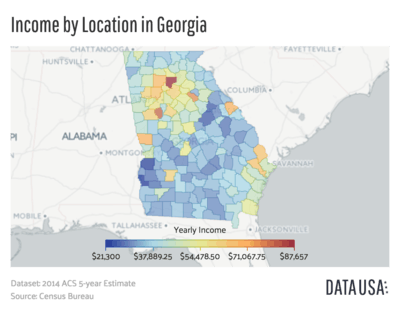
There are 15 Fortune 500 companies and 26 Fortune 1000 companies with headquarters in Georgia, including such names as Home Depot, UPS, Coca-Cola, Delta Air Lines, Aflac, Southern Company, Anthem Inc. (one of the largest health benefits companies), Honeywell, and SunTrust Banks. Hartsfield-Jackson Atlanta International Airport, the world's busiest airport as measured by both passenger traffic and aircraft traffic, is located in Georgia.[80][81] Georgia has over 1,700 internationally headquartered facilities representing 43 countries, employing more than 112,000 Georgians with an estimated capital investment of $23 billion.
Atlanta has a large effect on the state of Georgia, the Southeastern United States, and beyond. Atlanta has been the site of growth in real estate, service, logistics and the communications and film industries, while tourism is important to the economy. Atlanta is a global city, also called world city or sometimes alpha city or world center, as a city generally considered to be an important node in the global economic system.
For the past four years, Georgia has been ranked the top state in the nation to do business.[82]
Agriculture

Widespread farms produce peanuts, corn, and soybeans across middle and south Georgia. The state is the number one producer of pecans in the world, with the region around Albany in southwest Georgia being the center of Georgia's pecan production. Gainesville in northeast Georgia touts itself as the Poultry Capital of the World. Georgia is in the top five blueberry producers in the United States.[83]

Georgia's agricultural outputs include poultry and eggs, pecans, peaches, cotton, peanuts, rye, cattle, hogs, dairy products, turfgrass, timber, particularly pine trees, tobacco and vegetables.
Mining
Major products in the mineral industry include a variety of clays, stones, sands and the clay palygorskite, known as attapulgite.
Industry
Industry in Georgia is diverse.
The textile industry is located around the cities of Rome, Columbus, Augusta, Macon and along the I-75 corridor between Atlanta and Chattanooga, Tennessee, to include the towns of Cartersville, Calhoun, Ringgold and Dalton (the Carpet Capital of the World).[84]
In November 2009, Kia started production at the first U.S. Kia Motors plant, Kia Motors Manufacturing Georgia in West Point.
Industrial output includes textiles and apparel, transportation equipment, food processing, paper products, chemical products, and electric equipment.
Logistics
The Georgia Ports Authority owns and operates four ports in the state: Port of Savannah, Port of Brunswick, Port Bainbridge, and Port Columbus. The Port of Savannah is the fourth largest seaport in the United States, importing and exporting a total of 2.3 million TEUs per year.[85] Several major companies including Target, IKEA, and Heineken operate distribution centers in close proximity to the Port of Savannah.
Military
Georgia has one of the largest military presences in the country. Several US military installations are located in the state including Fort Stewart, Hunter Army Airfield, Naval Submarine Base Kings Bay, Fort Benning, Moody Air Force Base, Robins Air Force Base, Fort Gordon, Marine Corps Logistics Base Albany, Dobbins Air Reserve Base, Coast Guard Air Station Savannah and Coast Guard Station Brunswick.
Energy use and production
Georgia's electricity generation and consumption are among the highest in the United States, with natural gas being the primary electrical generation fuel, followed by coal. However, the state also has two nuclear power plants which contribute almost one fourth of Georgia's electricity generation. In 2013, the generation mix was 39% gas, 35% coal, 23% nuclear, 3% hydro and other renewable sources. The leading area of energy consumption is the industrial sector because Georgia "is a leader in the energy-intensive wood and paper products industry".[86] Solar generated energy is becoming more in use with solar energy generators currently installed ranking Georgia 15th in the country in installed solar capacity. In 2013, $189 million was invested in Georgia to install solar for home, business and utility use representing a 795% increase over the previous year.[87]
State taxes
Georgia has a progressive income tax structure with six brackets of state income tax rates that range from 1% to 6%. In 2009, Georgians paid 9% of their income in state and local taxes, compared to the US average of 9.8% of income.[88] This ranks Georgia 25th among the states for total state and local tax burden.[88] The state sales tax in Georgia is 4%[89] with additional percentages added through local options (e.g. Special-purpose local-option sales tax or SPLOST), but there is no sales tax on prescription drugs, certain medical devices, or food items for home consumption.[90]
The state legislature may allow municipalities to institute local sales taxes and special local taxes, such as the 2% SPLOST tax and the 1% sales tax for MARTA serviced counties. Excise taxes are levied on alcohol, tobacco, and motor fuel. Owners of real property in Georgia pay property tax to their county. All taxes are collected by the Georgia Department of Revenue and then properly distributed according to any agreements that each county has with its cities.
Film
The Georgia Film, Music and Digital Entertainment Office promotes filming in the state.[91] Since 1972, seven hundred film and television projects have been filmed on location in Georgia.[92] In 2008–2009, Georgia's film and television industry created a $1.15 billion economic impact on the state's economy.[93]
Tourism
In the Atlanta area, World of Coke, Georgia Aquarium, Zoo Atlanta and Stone Mountain are important tourist attractions.[94][95] Stone Mountain is Georgia's "most popular attraction"; receiving over four million tourists per year.[96][97] The Georgia Aquarium, in Atlanta, was the largest aquarium in the world in 2010 according to Guinness World Records.[98]
Callaway Gardens, in western Georgia, is a family resort.[99] The area is also popular with golfers.
The Savannah Historic District attracts over eleven million tourists each year.[100]
The Golden Isles are a string of barrier islands off the Atlantic coast of Georgia near Brunswick that include beaches, golf courses and the Cumberland Island National Seashore.
Several sites honor the lives and careers of noted American leaders: the Little White House in Warm Springs, which served as the summer residence of President Franklin Delano Roosevelt while he was being treated for polio; President Jimmy Carter's hometown of Plains and the Carter Presidential Center in Atlanta; the Martin Luther King, Jr., National Historic Site in Atlanta, which is the final resting place of Martin Luther King, Jr. and Coretta Scott King; and Atlanta's Ebenezer Baptist Church, where Dr. King preached.
Cultural

Fine and performing arts
Georgia's major fine art museums include the High Museum of Art and the Michael C. Carlos Museum, both in Atlanta; the Georgia Museum of Art on the campus of the University of Georgia in Athens; Telfair Museum of Art and the SCAD Museum of Art in Savannah; and the Morris Museum of Art in Augusta.[101]
The state theatre of Georgia is the Springer Opera House located in Columbus.
The Atlanta Opera brings opera to Georgia stages.[102] The Atlanta Symphony Orchestra is the most widely recognized orchestra and largest arts organization in the southeastern United States.[103]
There are a number of performing arts venues in the state, among the largest are the Fox Theatre, and the Alliance Theatre at the Woodruff Arts Center, both on Peachtree Street in Midtown Atlanta as well as the Cobb Energy Performing Arts Centre, located in Northwest Atlanta.
Literature
The rich heritage and southern antebellum atmosphere of Georgia has given rise to a great number of works such as Margaret Mitchell's Gone with the Wind, Olive Ann Burns' Cold Sassy Tree, and Alice Walker's The Color Purple.
A number of noted authors, poets and playwrights have lived in Georgia such as James Dickey, Flannery O'Connor, Sidney Lanier, Frank Yerby and Lewis Grizzard.[104]
Television
Well-known television shows set in Atlanta include, from Tyler Perry Studios, House of Payne and Tyler Perry's Meet the Browns, The Real Housewives of Atlanta, the CBS sitcom Designing Women, Matlock, the popular AMC series The Walking Dead, Lifetime Drop Dead Diva, Rectify and numerous HGTV original productions.
The Dukes of Hazzard, a 1980s TV show that spun off several films, was set in the fictional Hazzard County, Georgia. The show was filmed at Warner Bros. back lot in Burbank, California and on location in Conyers and Covington, Georgia as well as some locations in Atlanta.
Also filmed in Georgia is The Vampire Diaries, using Covington as the setting for the fictional Mystic Falls.
Music
A number of notable musicians in various genres of popular music are from Georgia. Included is Ray Charles (whose many hits include "Georgia on My Mind", now the official state song), and Gladys Knight (known for her Georgia-themed song, "Midnight Train to Georgia").
Rock groups from Georgia include the Atlanta Rhythm Section, The Black Crowes, and The Allman Brothers.
The university city of Athens sparked an influential rock music scene in the 1980s and 1990s. Among the groups achieving their initial prominence in that city were R.E.M., Widespread Panic, and the B-52's.
Since the 1990s, various hip-hop and R&B musicians have included top-selling artists such as Outkast, Usher, Ludacris, TLC, B.o.B., and Ciara. Atlanta is mentioned in a number of these artists' tracks, such as Usher's "A-Town Down" reference in his 2004 hit Yeah! (which also features Atlanta artists Lil Jon and Ludacris), Ludacris' "Welcome to Atlanta", Outkast's album "ATLiens", and B.o.B.'s multiple references to Decatur, such as in his hit song "Strange Clouds".
Film
Films set in Georgia include two pictures both set in Atlanta that were awarded the Oscar for Best Picture:, Gone with the Wind (1939) and Driving Miss Daisy (1989). Other films set in Georgia include Deliverance (1972), which was based on the novel of the same name by James Dickey, and Parental Guidance (2012).
Sports
%2C_Sanford_Stadium%2C_September_2007.jpg)
Sports in Georgia include professional teams in all major sports, Olympic Games contenders and medalists, collegiate teams in major and small-school conferences and associations, and active amateur teams and individual sports. The state of Georgia has a team in three major professional leagues — Atlanta Braves of Major League Baseball, Atlanta Falcons of the National Football League, Atlanta Hawks of the National Basketball Association — and in 2017 is scheduled to land a fourth with an expansion franchise in Major League Soccer.
The Georgia Bulldogs (Southeastern Conference), Georgia Tech Yellow Jackets (Atlantic Coast Conference), Georgia State Panthers and Georgia Southern Eagles (Sun Belt Conference) are Georgia's NCAA Division I FBS football teams, having won multiple national championships between them.
The 1996 Summer Olympics took place in Atlanta. The stadium that was built to host various Olympic events was converted to Turner Field, the home of the Atlanta Braves.
The Masters golf tournament, the first of the PGA tour's four "majors", is held annually the second weekend of April at the Augusta National Golf Club. The Atlanta Motor Speedway hosts the Dixie 500 NASCAR Cup Series stock car race and Road Atlanta the Petit Le Mans endurance sports car race.
Atlanta's Georgia Dome hosted Super Bowl XXVIII in 1994 and Super Bowl XXXIV in 2000. The Georgia Dome hosted the NCAA Final Four Men's Basketball National Championship in 2002, 2007, and 2013.[105] It hosted WWE's WrestleMania XXVII in 2011, an event which set an attendance record of 71,617. The dome is also the venue of the annual Chick-fil-A Bowl post-season college football games. Since 2004 the FIRST World Championships have been held there.
Professional baseball's Ty Cobb was the first player inducted into the Baseball Hall of Fame. He was from Narrows and was nicknamed "The Georgia Peach."[106]
Parks and recreational activities
There are 63 parks in Georgia, 48 of which are state parks and 15 that are historic sites, and numerous state wildlife preserves, under the supervision of the Georgia Department of Natural Resources.[107] Other historic sites and parks are supervised by the National Park Service and include the Andersonville National Historic Site in Andersonville; Appalachian National Scenic Trail; Chattahoochee River National Recreation Area near Atlanta; Chickamauga and Chattanooga National Military Park at Fort Oglethorpe; Cumberland Island National Seashore near St. Marys; Fort Frederica National Monument on St. Simons Island; Fort Pulaski National Monument in Savannah; Jimmy Carter National Historic Site near Plains; Kennesaw Mountain National Battlefield Park near Kennesaw; Martin Luther King, Jr., National Historic Site in Atlanta; Ocmulgee National Monument at Macon; Trail of Tears National Historic Trail; and the Okefenokee Swamp in Waycross, Georgia[108]
Outdoor recreational activities include hiking along the Appalachian Trail; Civil War Heritage Trails; rock climbing and whitewater paddling.[109][110][111][112] Other outdoor activities include hunting and fishing.
Education
Georgia county and city public school systems are administered by school boards with members elected at the local level. As of 2013, all but 19 of 181 boards are elected from single-member districts. Residents and activist groups in Fayette County, Georgia sued the board of commissioners and school board for maintaining an election system based on at-large voting, which tended to increase the power of the majority and effectively prevented minority participation on elected local boards for nearly 200 years.[113] A change to single-member districts has resulted in the African-American minority being able to elect representatives of its choice.
Georgia high schools (grades nine through twelve) are required to administer a standardized, multiple choice End of Course Test, or EOCT, in each of eight core subjects including algebra, geometry, U.S. history, economics, biology, physical science, Ninth Grade Literature and composition, and American literature. The official purpose of the tests is to assess "specific content knowledge and skills." Although a minimum test score is not required for the student to receive credit in the course, completion of the test is mandatory. The EOCT score accounts for 15% of a student's grade in the course.[114] The Georgia Milestone is taken by public school students in the state.[115]
Georgia has almost 70 public colleges, universities, and technical colleges in addition to over 45 private institutes of higher learning. Among Georgia's public universities is the flagship research university, University of Georgia, the oldest public university in the United States. The University System of Georgia is the presiding body over public education in the state. The System includes 29 institutions of higher learning. The System is governed by the Georgia Board of Regents.
The HOPE Scholarship, funded by the state lottery, is available to all Georgia residents who have graduated from high school or earned a General Educational Development certificate. The student must maintain a 3.2 or higher grade point average and attend a public college or university in the state.
Media

The Atlanta metropolitan area is the ninth largest media market in the United States as ranked by Nielsen Media Research. The state's other top markets are Savannah (95th largest), Augusta (115th largest), and Columbus (127th largest).[116]
There are 48 television broadcast stations in Georgia including TBS, TNT, TCM, Cartoon Network, CNN and Headline News, all founded by notable Georgia resident Ted Turner. The Weather Channel also has its headquarters in Atlanta.
By far, the largest daily newspaper in Georgia is the Atlanta Journal-Constitution with a daily readership of 195,592 and a Sunday readership of 397,925.[117] Other large dailies include The Augusta Chronicle, the Columbus Ledger-Enquirer, The Telegraph (formerly The Macon Telegraph) and the Savannah Morning News.
WSB-AM in Atlanta was the first licensed radio station in the southeastern United States, signing on in 1922. Georgia Public Radio has been in service since 1984[118][119] and, with the exception of Atlanta, it broadcasts daily on several FM (and one AM) stations across the state. Georgia Public Radio reaches nearly all of Georgia (with the exception of the Atlanta area, which is served by WABE).
WSB-TV in Atlanta is the state's oldest television station, having begun operations in 1948. WSB was only the second such operation founded in the Southern U.S., trailing only WTVR in Richmond, Virginia.
Infrastructure
Transportation
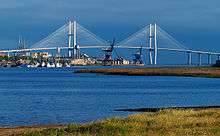
Transportation in Georgia is overseen by the Georgia Department of Transportation, a part of the executive branch of the state government. Georgia's major Interstate Highways are I-20, I-75, I-85, and I-95. On March 18, 1998, the Georgia House of Representatives passed a resolution naming the portion of Interstate Highway 75, which runs from the Chattahoochee River northward to the Tennessee state line the Larry McDonald Memorial Highway. Larry McDonald, a Democratic member of the House of Representatives, had been on Korean Air Lines Flight 007 when it was shot down by the Soviets on September 1, 1983.

Georgia's primary commercial airport is Hartsfield–Jackson Atlanta International Airport (ATL), and is the world's busiest passenger airport.[120] In addition to Hartsfield-Jackson, there are eight other airports serving major commercial traffic in Georgia. Savannah/Hilton Head International Airport is the second-busiest airport in the state as measured by passengers served, and is the only additional international airport. Other commercial airports (ranked in order of passengers served) are located in Augusta, Columbus, Albany, Macon, Brunswick, Valdosta, and Athens.[121]
The Georgia Ports Authority manages two deepwater seaports, at Savannah and Brunswick, and two river ports, at Bainbridge and Columbus. The Port of Savannah is a major U.S. seaport on the Atlantic coast.
The Metropolitan Atlanta Rapid Transit Authority (MARTA) is the principal rapid transit system in the Atlanta metropolitan area. Formed in 1971 as strictly a bus system, MARTA operates a network of bus routes linked to a rapid transit system consisting of 48 miles (77 km) of rail track with 38 train stations. MARTA operates almost exclusively in Fulton and DeKalb counties, with bus service to two destinations in Cobb county and the Cumberland Transfer Center next to the Cumberland Mall, and a single rail station in Clayton County at Hartsfield-Jackson Atlanta International Airport. MARTA also operates a separate paratransit service for disabled customers. As of 2009, the average total daily ridership for the system (bus and rail) was 482,500 passengers.[122]
Health care
.jpg)
The state has 151 general hospitals, over 15,000 doctors and almost 6,000 dentists.[123] The state is ranked forty-first in the percentage of residents who engage in regular exercise.[124]
Cities
Atlanta, located in north-central Georgia at the Eastern Continental Divide, has been Georgia's capital city since 1868. It is the most populous city in Georgia, with just over 420,000 residents in 2010.[125]
The Atlanta metropolitan area is the cultural and economic center of the Southeast, and its population in 2010 was 5,268,860, or 53.6% of Georgia's total. Atlanta is the nation's ninth largest metropolitan area.[126]
The state has fourteen other cities with populations above 50,000 (based on 2012 census estimates).[127] In descending order of size they are Columbus, Augusta, Macon, Savannah, Athens, Sandy Springs, Roswell, Albany, Johns Creek, Warner Robins, Alpharetta, Marietta, Valdosta and Smyrna.
Along with the rest of the Southeast, Georgia's population continues to grow rapidly, with primary gains concentrated in urban areas. The population of the Atlanta metropolitan area added 1.23 million people (24 percent) between 2000 and 2010, and Atlanta rose in rank from the eleventh largest metropolitan area in the United States to the ninth largest.[128]
Notable people
Jimmy Carter, from Plains, Georgia, was President of the United States from 1977 to 1981. Martin Luther King Jr. was born in Atlanta, Georgia (U.S. state) in 1929. He was a civil rights movement leader fighting for rights for African Americans and received the Nobel Peace Prize in 1964.[129]
State symbols


- Amphibian: American green tree frog
- Bird: brown thrasher
- Butterfly: eastern tiger swallowtail
- Dance: square dance
- Fish: largemouth bass
- Flower: Cherokee rose
- Food: grits, peach, Vidalia onion
- Fossil: shark tooth
- Gem: quartz
- Insect: European honey bee
- Mammal: White-tailed deer [130]
- Marine mammal: right whale
- Mineral: staurolite
- Nicknames:
- "Peach State"
- "Empire State of the South"[131]
- Reptile: gopher tortoise
- Rock: granite
- Shell: knobbed whelk
- Soil: Tifton
- Song: "Georgia on My Mind"
- Tree: live oak
See also
- Geologic map of Georgia
- Get Outdoors Georgia
- Index of Georgia (U.S. state)-related articles
- Outline of Georgia (U.S. state) – organized list of topics about Georgia
- LGBT rights in Georgia (U.S. state)
![]() Georgia (U.S. state) – Wikipedia book
Georgia (U.S. state) – Wikipedia book
References
- 1 2 3 "Table 1. Annual Estimates of the Resident Population for the United States, Regions, States, and Puerto Rico: April 1, 2010 to July 1, 2015" (CSV). U.S. Census Bureau. December 23, 2015. Retrieved December 23, 2015.
- 1 2 "Elevations and Distances in the United States". United States Geological Survey. 2001. Retrieved October 21, 2011.
- ↑ Elevation adjusted to North American Vertical Datum of 1988.
- ↑ "Georgia History Overview – The History Channel". The History Channel. Retrieved February 20, 2012.
- ↑ "Georgia at the Online Etymology Dictionary". Online Etymology Dictionary. Retrieved February 20, 2012.
- 1 2 3 4 "New Georgia Encyclopaedia". The New Georgia Encyclopedia. Retrieved February 20, 2012.
- ↑ "Coweta is the 41st fastest growing county in United States". The Times-Herald. Retrieved May 22, 2010.
- ↑ TIGER database (January 1, 2010). "State Area Measurements and Internal Point Coordinates". Census.gov. United States Census. Retrieved April 23, 2016.
- ↑ "Georgia Facts and Symbols - Georgia.gov".
- ↑ "Trustee Georgia, 1732–1752". Georgiaencyclopedia.org. July 27, 2009. Retrieved October 24, 2010.
- ↑ "The Articles of Confederation: Primary Documents of American History (Virtual Programs & Services, Library of Congress)". Loc.gov. July 10, 2014. Retrieved July 27, 2014.
- ↑ "A Resolution". Georgia General Assembly. Retrieved June 26, 2012.
- ↑ ""Atlanta in the Civil Rights Movement", Atlanta Regional Council for Higher Education". Atlantahighered.org. Retrieved July 27, 2014.
- 1 2 Crowe, Charles (January 1, 1968). "Racial Violence and Social Reform-Origins of the Atlanta Riot of 1906". The Journal of Negro History. 53 (3): 234–256. doi:10.2307/2716218. JSTOR 2716218.
- ↑ Historical Census Browser, 1900 Federal Census, University of Virginia, accessed March 15, 2008
- ↑ Ulrich Bonnell Phillips (1902). Georgia and state rights: a study of the political history of Georgia from the Revolution to the Civil War. Annual Report of American Historical Association for the 57th US Congress, 1901. p. 30. Retrieved October 23, 2012.
- ↑ "Drought-stricken Georgia eyes Tennessee's border - and river water". Los Angeles Times. Los Angeles, California. February 10, 2010.
- 1 2 3 "Georgia – Flora and fauna". City-data.com. Retrieved July 27, 2014.
- ↑ Monthly Averages for Macon, GA The Weather Channel.
- ↑ Monthly Averages for Clayton, GA The Weather Channel.
- ↑ "Georgia USDA Plant Hardiness Zone Map". Retrieved November 11, 2010.
- ↑ Each state's high temperature record USA Today, last updated August 2004.
- ↑ Each state's low temperature record USA Today, last updated August 2006
- 1 2 Wurman, Joshua. "Why don't tornadoes hit cities more often?". scientificamerican.com. SCIENTIFIC AMERICAN, A DIVISION OF NATURE AMERICA, INC. Retrieved June 10, 2016.
- ↑ "Weather By Day Georgia". Weatherbyday.com. Retrieved October 24, 2010.
- ↑ "Census". US: Government. 2010. Archived from the original on July 21, 2011. Retrieved August 5, 2011.
|contribution=ignored (help) - ↑ "Illegals on rise in Southeast". Melbourne, FL: Florida Today. Associated Press. February 24, 2010. p. 6A.
- ↑ Kanell, Michael E. (November 16, 2009). "Number of veterans, October". Atlanta, Georgia: Atlanta Constitution-Journal. pp. A6. quoting the Bureau of Labor Statistics.
- ↑ "American FactFinder". Census. October 5, 2010. Retrieved August 5, 2011.
- ↑ "Historical Census Statistics on Population Totals By Race, 1790 to 1990, and By Hispanic Origin, 1970 to 1990, For The United States, Regions, Divisions, and States". Census.gov. Retrieved July 27, 2014.
- ↑ Population of Georgia: Census 2010 and 2000 Interactive Map, Demographics, Statistics, Quick Facts
- ↑ "2010 Census Data". Census.gov. Retrieved July 27, 2014.
- ↑ Exner, Rich (June 3, 2012). "Americans under age 1 now mostly minorities, but not in Ohio: Statistical Snapshot". The Plain Dealer.
- ↑ "SELECTED SOCIAL CHARACTERISTICS IN THE UNITED STATES-2011 American Community Survey 1-Year Estimates". Retrieved September 4, 2013.
- ↑ "American FactFinder". Census. Retrieved February 11, 2012.
- ↑ "Persons Who Reported at Least One Specific Ancestry Group for Regions, Divisions and States" (PDF). Census. 1980. Retrieved October 23, 2012.
- ↑ Pulera, Dominic J, Sharing the Dream: White Males in a Multicultural America
- ↑ Farley, Reynolds (August 1991), "The New Census Question about Ancestry: What Did It Tell Us?", Demography, 28 (3): 414, 421, doi:10.2307/2061465, PMID 1936376
- ↑ Lieberson, Stanley; Santi, Lawrence (1985), "The Use of Nativity Data to Estimate Ethnic Characteristics and Patterns", Social Science Research, 14 (1): 44–6, doi:10.1016/0049-089x(85)90011-0
- ↑ Lieberson, Stanley; Waters, Mary C (September 1986), "Ethnic Groups in Flux: The Changing Ethnic Responses of American Whites", Annals of the American Academy of Political and Social Science, 487 (79): 82–86, doi:10.1177/0002716286487001004
- ↑ Frey, William H (May 2004), The New Great Migration: Black Americans' Return to the South, 1965–2000 (PDF), The Brookings Institution, archived from the original (PDF) on April 28, 2008, retrieved May 19, 2008.
- ↑ Atlanta (PDF) (profile), GA: Oca, archived from the original (PDF) on July 11, 2009.
- ↑ "Georgia", Quickfacts, Census, archived from the original on June 22, 2015.
- ↑ "Early Mountain Life", Travel, Georgia, archived from the original on May 4, 2008
- ↑ Who are Americans, The well
- 1 2 "Georgia". Modern Language Association. Retrieved August 12, 2013.
- ↑ "Maps". Pew Forum on Religion & Public Life. Retrieved October 24, 2010.
- ↑ "The Association of Religion Data Archives | State Membership Report". www.thearda.com. Retrieved November 7, 2013.
- ↑ "www.thearda.com/rcms2010/r/s/13/rcms2010_13_state_name_2010.asp". Thearda.com. Retrieved July 27, 2014.
- ↑ "www.georgiaencyclopedia.org/articles/arts-culture/presbyterian-church-america". Georgiaencyclopedia.org. Retrieved July 27, 2014.
- ↑ Weiszer, Marc (September 29, 2014). "Georgia's Kublanow balances faith and football". Savannah Now.
Kublanow wasn't just born Jewish, he was raised and had his bar mitzvah while attending an orthodox Chabad synagogue. His mother, Shelly Kublanow Rosenblatt, will attend Friday night and Saturday morning services at the Chabad House in Athens and then head to Sanford Stadium in the afternoon to watch Kublanow and his linemates clear the way for Todd Gurley.
- ↑ Sollish, Ari (October 11, 2007). "Chabad Course Explores Israel's Spiritual Side". Crown Heights Info.
ATLANTA, GA — A new six-part adult-education course from Chabad-Lubavitch's Rohr Jewish Learning Institute will explore the spiritual connection between the Jewish people and the land of Israel starting at the end of October. Unlike courses that focus on the history or the culture of Israel, "The Land & the Spirit: Why We All Care About Israel" will explore the mystery of the deep connection between Jews everywhere and that small patch of land in the Middle East.
- ↑ Senate Kids. Retrieved December 30, 2007.
- ↑ Constitution of Georgia Article III Section II. Retrieved December 30, 2007. Archived December 9, 2007, at the Wayback Machine.
- ↑ "The Supreme Court of Georgia History". Supreme Court of Georgia. Retrieved November 26, 2016.
- ↑ A Brief History of Georgia Counties. Retrieved December 30, 2007. Archived November 2, 2007, at the Wayback Machine.
- ↑ "Georgia's County Governments". Georgiaencyclopedia.org. June 5, 2014. Retrieved July 27, 2014.
- ↑ Niesse, Mark (January 21, 2016). "Townships proposed as an alternative to cities in Georgia". Atlanta Journal-Constitution. Retrieved April 8, 2016.
- ↑ "Race, Voting Rights, and Segregation". University of Michigan. Retrieved October 15, 2016.
- 1 2 Saye, Albert B. A Constitutional History of Georgia, 1732-1945. University of Georgia Press. Retrieved May 18, 2016.
- ↑ "Georgia's 1908 Disfranchisement Constitutional Amendment". Ray City History. Ray City Community Library. Retrieved May 18, 2016.
- ↑ Historical Census Browser, 1900 US Census, University of Virginia. Retrieved March 15, 2008. Archived August 23, 2007, at the Wayback Machine.
- ↑ "A State Divided". Ourgeorgiahistory.com. Retrieved July 27, 2014.
- ↑ "The long goodbye". Economist.com. November 11, 2010. Retrieved September 3, 2013.
- ↑ "The Confident Years". Ngeorgia.com. Retrieved July 27, 2014.
- ↑ "Last white Democrat in House from Deep South wins re-election". Reuters.com. Retrieved September 3, 2013.
- ↑ "White voters solidly in for GOP in Georgia (October 16, 2012)". Ajc.com. October 16, 2012. Retrieved July 27, 2014.
- 1 2 "Election 2004". CNN. Retrieved October 24, 2010.
- ↑ "Partisan composition of state houses". Ballotpedia. Ballotpedia. Retrieved May 18, 2016.
- ↑ "Georgia State Senate". Ballotpedia. Ballotpedia. Retrieved May 18, 2016.
- ↑ "Georgia Marriage Amendment, Question 1 (2004)". Ballotpedia. Retrieved May 22, 2010.
- ↑ Bluestein, Greg (June 29, 2015). "Top Georgia court official: Judges are following the law on gay marriages". Atlanta, Georgia: Atlanta Constitution-Journal.
- ↑ Jay (April 16, 2009). "Georgia Senate threatens dismantling of USA | Jay Bookman". Blogs.ajc.com. Retrieved May 22, 2010.
- ↑ "sr632.html". Legis.ga.gov. Retrieved May 22, 2010.
- ↑ Bookman, Jay (April 16, 2009). "Atlanta News, Sports, Atlanta Weather, Business News". ajc.com. Retrieved May 22, 2010.
- ↑ "GDP by State". Greyhill Advisors. Retrieved September 7, 2011.
- ↑ "Per Capita Personal Income by State". Bureau of Business & Economic Research, UNM. Retrieved April 21, 2013.
- ↑ "State credit ratings". ballotpedia.org. Ballotpedia. Retrieved July 22, 2016.
- ↑ "BEA statistics for 2005 GSP – October 26, 2006". Bea.gov. May 23, 2011. Retrieved July 27, 2014.
- ↑ Tharpe, Jim (January 4, 2007). "Atlanta Airport Still the "Busiest"". The Atlanta Journal-Constitution. Archived from the original on January 6, 2007. Retrieved January 4, 2007.
- ↑ "Hartsfield-Jackson Atlanta International Airport". Delta Air Lines, Inc. Retrieved June 23, 2013.
- ↑ Belser, Briana. "State of Georgia ranked No. 1 in business". CBS46.com. WGCL-TV (Meredith Corporation). Retrieved November 3, 2016.
- ↑ "Did You Know?". Georgia Blueberry Commission. Georgia Department of Agriculture. Retrieved January 11, 2015.
- ↑ Lohr, Kathy (September 3, 2013) "New Carpet Factories Help Cushion Blows From Recession Losses". npr.org. Retrieved March 19, 2014.
- ↑ "Port of Savannah fourth-busiest, fastest-growing in the U.S.". Atlanta Business Chronicle. American City Business Journals. Retrieved August 26, 2013.
- ↑ "Energy Information Administration". Tonto.eia.doe.gov. March 27, 2014. Retrieved July 27, 2014.
- ↑ "Facts on the Georgia Solar Industry". Georgia Solar. Solar Energy Industries Association. Retrieved January 12, 2015.
- 1 2 "Georgia's State and Local Tax Burden 1977–2009". The Tax Foundation. Retrieved February 8, 2012.
- ↑ https://etax.dor.ga.gov/salestax/salestaxrates/LGS_2014_Jul_Rate_Chart.pdf
- ↑ "Georgia Public Policy Foundation" (PDF). Gppf.org. Retrieved October 23, 2012.
- ↑ Film Industry in Georgia. (2004–2010). The New Georgia Encyclopedia. Retrieved April 1, 2010.
- ↑ Georgia Industries: Film Facts. (2010). Georgia. Retrieved April 1, 2010.
- ↑ Georgia Industries: Film & TV. (2010). georgia.org. Retrieved April 1, 2010.
- ↑ Zoo Atlanta. Retrieved December 8, 2007.
- ↑ Circues. Retrieved December 8, 2007.
- ↑ Alexander, Sheridan "Stone Mountain Park - Georgia's Most Popular Attraction". gosoutheast.about.com. Retrieved November 28, 2014.
- ↑ Rattlesnake Roundups. Retrieved December 8, 2007.
- ↑ Associated Press "Aquarium sets Guinness record - Official from world record book says aquarium is world's largest". ajc.com. Retrieved November 28, 2014.
- ↑ Callaway Gardens. Retrieved December 8, 2007
- ↑ "Savannah GA Historical Information". Savannahvisit.com. Retrieved October 23, 2012.
- ↑ Willamette. Retrieved December 8, 2007. Archived October 5, 2010, at the Wayback Machine.
- ↑ Atlanta Opera. Retrieved December 8, 2007
- ↑ Atlanta Symphony Orchestra. Retrieved December 8, 2007.
- ↑ Literature: Overview. Retrieved December 5, 2007.
- ↑ Tucker, Tim (March 19, 2012). "Atlanta tunes up for Final Four with South region". Atlanta Journal Constitution. Retrieved August 26, 2013.
- ↑ "Cobb, Ty". National Baseball Hall of Fame and Museum. Retrieved December 19, 2012.
- ↑ Georgia Department of Natural Resources gadnr.org, accessed May 13, 2007
- ↑ National Park Service nps.gov, accessed May 13, 2007
- ↑ Appalachian Trail. Retrieved December 8, 2007.
- ↑ Civil War Heritage Trails. Retrieved December 8, 2007.
- ↑ Rock climbing. Retrieved December 8, 2007.
- ↑ "Whitewater rafting". Georgiaencyclopedia.org. July 1, 2014. Retrieved July 27, 2014.
- ↑ Staff, A. B. S. (May 22, 2013). "Fayette County At-Large Election Process Violates Voting Rights Act".
- ↑ GA DOE – Testing – EOCT. Retrieved April 24, 2008. Archived May 2, 2010, at the Wayback Machine.
- ↑ Lowry, Donna (September 2, 2014). "New Georgia test will be different from CRCT". 11 Alive. Retrieved August 9, 2015.
- ↑ "210 Designated Market Areas – 03–04". Nielsen Media. Archived from the original on May 17, 2006. Retrieved February 7, 2012.
- ↑ "AJC circulation continues to fall". Atlanta Business Chronicle. American City Business Journals. April 26, 2010.
- ↑ Network, Georgia Public Radio, archived from the original on February 2, 2007, retrieved May 19, 2007
- ↑ About, Georgia Public Radio, archived from the original on May 3, 2007, retrieved May 19, 2007
- ↑ "Airport information", Hartsfield-Jackson Atlanta International Airport, retrieved June 18, 2008
- ↑ "Public-Use Airports", Georgia Encyclopedia, retrieved June 27, 2011
- ↑ Dawson, Christie (Third quarter 2009), Public Transportation Ridership Report (PDF), American Public Transit Association Check date values in:
|date=(help) - ↑ "Living in Georgia", Culture, retrieved May 16, 2007
- ↑ "Physical exercise", Health (graph), Statemaster, retrieved May 16, 2007
- ↑ "US Census Bureau". 2010.census.gov. March 17, 2011. Retrieved June 27, 2011.
- ↑ "Metropolitan Area Population & Housing Patterns: 2000–2010". Proximityone.com. Retrieved October 23, 2012.
- ↑ "American FactFinder". Factfinder2.census.gov. Retrieved August 5, 2011.
- ↑ "Atlanta moves to 9th largest US Metro area". www.ajc.com. Retrieved October 23, 2012.
- ↑ Tieck, Sarah (2013). Georgia. Minneapolis, MN: ABDO Publishing Company. p. 22. ISBN 978-1-61783-348-9.
- ↑ "White-Tailed Deer Named State Mammal of Georgia - Georgia.gov".
- ↑ "Look Georgia Agriculture on www.georgia.gov" (PDF). Archived from the original (PDF) on July 22, 2011. Retrieved August 5, 2011.
Bibliography
- Bartley, Numan V. The Creation of Modern Georgia (1990). Covers 1865–1990 period. ISBN 0-8203-1183-9.
- Coleman, Kenneth. ed. A History of Georgia (1991). ISBN 0-8203-1269-X.
- London, Bonnie Bullard. (2005) Georgia and the American Experience Atlanta, Georgia: Clairmont Press ISBN 1-56733-100-9. A middle school textbook.
- Peirce, Neal R. The Deep South States of America: People, Politics, and Power in the Seven Deep South States (1974). Information on politics and economics 1960–72. ISBN 0-393-05496-9.
- Williams, David and Christopher C. Meyers. Georgia: A Brief History Macon: Mercer University Press, 2012.
External links
- Georgia state government website
- Georgia State Guide, from the Library of Congress
- The New Georgia Encyclopedia
- Georgia State Facts from USDA
- Vanishing Georgia from the Digital Library of Georgia
- Virtual Georgia from the Georgia Archives
- Georgia (U.S. state) at DMOZ
-
 Geographic data related to Georgia (U.S. state) at OpenStreetMap
Geographic data related to Georgia (U.S. state) at OpenStreetMap
 |
|
|
 | |
| |
|
Atlantic Ocean | ||
| ||||
| | ||||
| |
Atlantic Ocean |
| Preceded by New Jersey |
List of U.S. states by date of statehood Ratified Constitution on January 2, 1788 (4th) |
Succeeded by Connecticut |
Coordinates: 33°00′N 83°30′W / 33°N 83.5°W
.svg.png)


